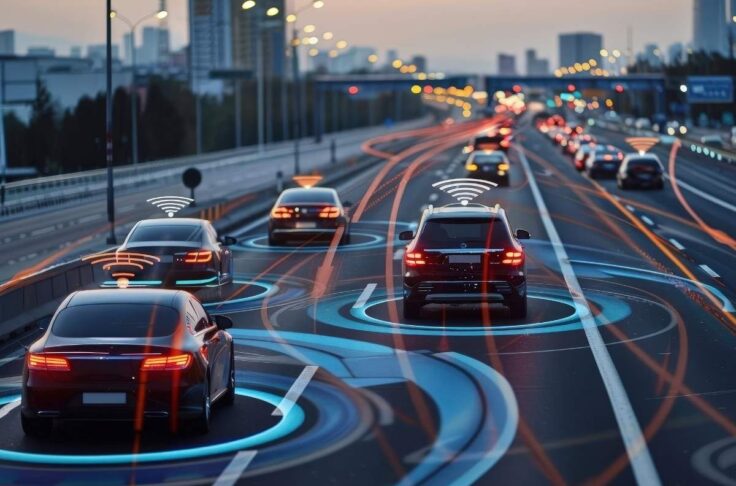Understanding the Impact of Connected Vehicles
Summary
Connected vehicle technology is being developed to add convenience to personal vehicles; in order to further enhance the value of shared mobility services, operators need to understand how telematics, V2X communication, and artificial intelligence can improve the user experience.

Connected vehicles are changing the driving experience. Almost 20 years ago, GPS was an impressive feature to support vehicle navigation, and now it is found in everyone’s smartphones. Similarly, the technology behind connected vehicles is expected to add conveniences people don’t even know they need to their day-to-day driving habits (Digital Trends).
When it comes to shared mobility, vehicles have always been connected in order to make sharing possible. The core features of vehicle lock and unlock, vehicle to device communication, and server reliability is still essential. However, with more connected vehicle technology, the opportunities to add further value is paramount.
Current Applications
According to shared mobility experts, service reliability and speed are key drivers to making shared mobility convenient for people. Specifically, vehicles must have strong connection to the server so a user can enter the vehicle in less than 30 seconds, which is the threshold that users have come to expect (AQTr).
Similarly, Bluetooth has changed the shared mobility experience. When car2go first started, they required users to answer prompts on the in-car screen, which also provided GPS navigation. However, since consumers rely more and more on their personal smartphones, vehicle manufacturers have leveraged Bluetooth to build out the in-car experience via apps, and have focused their development efforts elsewhere.
This change points to the need for OEM collaboration with mobility players, and the demand for purpose-built vehicles (McKinsey & Company). Instead of building connected vehicles for consumer convenience, shared mobility services need better telematics data and applications. This is especially true because autonomous vehicles need information and context to work with; telematics gathered from vehicles today and over the next few years will help advance the development of machine learning and simulate learned driving behaviour (Automotive World).
Looking into the future, we predict even more comprehensive uses of connected vehicle technology.
Telematics and Device Management
Currently, after-market telematics devices and software platforms enable oversight of fleet activity. As vehicles become more connected, these devices may be less important, but the need for a vehicle monitoring dashboard for fleet oversight, remote vehicle control, and over-the-air diagnostics will still play a critical role in all types of shared mobility services.
Operators will need a platform that can aggregate all the connected car data in the future, but also manage the vehicles using technology currently available. By using a comprehensive platform that can be used for both current and connected vehicles, shared mobility operators will be ready for the future of mobility. Given the rate of change in the mobility space, it is even more important for operators to have a solid foundation for their service, while giving them the flexibility to adapt to newer technologies.
In addition, shared mobility operators need to be cognizant of communication reliability with connected vehicles. Signal strengths that may be suitable for enhanced auto pilot may not be appropriate for shared mobility needs, such as quick keyless access in underground parkades or real-time GPS positioning. As a result, integrations with parties that have strengths in these areas may still be needed even as vehicles become more connected.
M2M Evolving to V2X
With 125 million connected vehicles expected to be shipped by 2022 (Counterpoint Research), the next four years should see shared mobility services further adapting more technology. Right now, current M2M (machine to machine) technology makes it possible for vehicles and smartphones to communicate with either GSM or Bluetooth running in parallel. This provides a higher guarantee that the vehicle will be accessible regardless of where it is located. In the future, this structure could be further developed to support V2X (vehicle to everything) communication (Autotrader).
With connected vehicles, vehicle data can communicate with smart city infrastructure to help cities better plan resources to meet current demand. For example, smart cities can collect the destination points of trips being made, and plan recommended routes and stoplight signals based on this information (IBM).
Mobility as a service will also change. Imagine getting a prompt to join a ride-pool as you are getting ready, since your calendar was synced with the MaaS app. On your way to work however, you realize you forgot to buy a gift for your colleague. You go online and the app recommends stores en route to work for easy order and pick-up.
To bridge the gap to the future, current M2M technology needs to be able to integrate with other software platforms, whether that be with payment platforms for seamless transactions or analytics platform for business intelligence insights. With more transparency and sharing of data, new mobility can better shape cities and infrastructure to help people better move around.
Artificial Intelligence and Driver Behaviour
Artificial intelligence is expected to be in 122 million vehicles by 2025, up from 7 million in 2015 (Venture Beat). Driver assist features can be further enhanced through artificial intelligence and personalization to each driver. By understanding a user’s driver behaviour, the vehicle can enable features that may be of interest to the driver, such as automatically adjusting vehicle temperature and finding nearby parking based on usual destinations. Similarly, the human to vehicle interaction could be enhanced, with gesture recognition triggering virtual assistance (Venture Beat).
With real-time driver behaviour data and predictive algorithms forecasting future driver behaviour, insurance pricing can also be dynamic to reflect true insurance coverage requirements. With insurance premiums as one of the larger overhead costs of shared mobility operations, this would allow operators to adjust their coverage as needed. While mobility operators will likely always cover this cost, it would be a good tool to educate users on how their driving style directly impacts risks and therefore costs.
Connected technology can also make the driving experience more enjoyable. Artificial intelligence should be equipped with the freedom to develop solutions based on complex data – unique driver behaviour (McKinsey & Company). The independence of vehicle management will open up new driving experiences that could add further efficiencies to trips made by vehicle. For example, if a user consistently drives under the speed limit, that may indicate discomfort driving too fast. So if the user’s destination is across town, the vehicle may suggest avoiding the highway, thereby reducing both the driver risk of being victim to tailgating and aggressive action from other drivers on the road.
The CASE for Connected and Shared
Of course, it is exciting to talk about what is going to be possible with connected vehicles. Connected vehicles will open up new opportunities for integration with infrastructure, data analytics, and more. Whether a vehicle comes connected or a vehicle becomes connected with after-market technology, the future of mobility will be more convenient.
Many discussions have taken place on what the future of mobility will look like. We agree that it will be electric and shared; it is already connected but has the potential to grow in scope; and it will also eventually be autonomous, but it is important for operators to focus on what they can control and improve upon now, rather than just waiting for new technology.
At INVERS, we are building our software and telematics toolkit to be the reliable operating system for shared mobility services today, while also preparing for the adoption of more connected vehicle technology.


